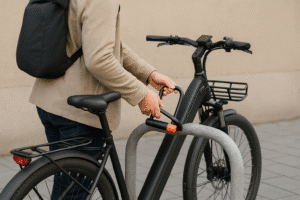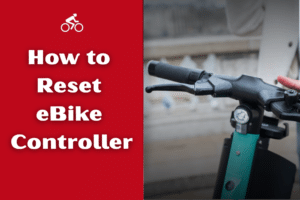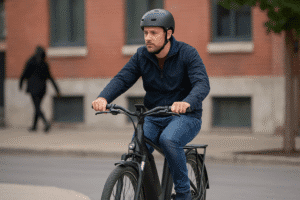If you ride often, you’ve probably wondered if it’s safe to store your electric bike outside. Maybe you don’t have garage space, or you simply want quick access for daily commutes.
The truth is, outdoor storage can work, but it depends on how and where you do it.
In this guide, we’ll cover everything you need to know about keeping your e-bike safe outdoors, protecting the battery, and avoiding common storage mistakes.
Key Takeaways:
- You can store an electric bike outside, but it needs protection from rain, heat, and cold.
- Always remove the battery and store it indoors when not riding.
- Use a waterproof, breathable cover and keep the bike under some form of shelter.
- Regular cleaning, drying, and light maintenance help prevent rust and extend lifespan.
Why Proper Storage Matters for Electric Bikes
Proper storage protects your electric bike from moisture, temperature damage, and corrosion that can ruin its battery, wiring, and frame over time.
When you invest in a good e-bike, you also invest in how you care for it. Leaving it out in the open may seem convenient, but weather and neglect can quickly cause wear and tear. Here’s what happens when you don’t store it properly:
- Battery damage: Heat, cold, and humidity all affect lithium-ion cells, shortening battery life.
- Corrosion: Rain or dew can rust the frame, chain, and bolts.
- Electronics failure: Moisture inside connectors or displays can lead to short circuits.
- Warranty risks: Many brands void coverage for water or weather-related damage.
If you want to keep your battery in top shape, check out our detailed guide on how to store an e-bike battery safely for step-by-step tips.
Can Electric Bikes Be Stored Outside?
Yes, electric bikes can be stored outside temporarily if they’re covered, locked, and protected from direct rain or sunlight. However, long-term outdoor storage requires extra precautions to prevent battery and rust damage.
If you ride daily, storing your e-bike outside overnight is usually fine as long as you use a waterproof cover and remove the battery.
Try to park it under a porch, shed, or other sheltered area. Avoid leaving it in full sun or during heavy rain, since both can cause gradual damage.
For longer periods, it’s better to find a semi-indoor spot such as a garage or bike shed. Direct exposure to humidity, snow, or heat can corrode parts and weaken the battery over time.
Think of it like parking your car; it works better when it’s protected from the elements.
How Long Can an Electric Bike Stay Outside Safely?
An electric bike can stay outside safely for a few days at a time if it’s dry, covered, and locked. Extended outdoor storage (weeks or months) can harm the battery and cause corrosion unless properly sheltered.
Short-term outdoor parking is fine, especially if the weather is mild. Just remove the battery and keep the bike covered. But if you leave it outside for long stretches, rain and condensation can build up in electrical parts.
I’ve seen riders lose 20–30% of their battery capacity within a season from improper storage. If possible, rotate between indoor and outdoor spots to give your e-bike a “rest” from the weather.
How to Store an Electric Bike Outside Safely
If outdoor storage is your only option, there are several ways to protect your bike year-round. A bit of setup goes a long way in keeping it running smoothly.
Use a Quality Waterproof Cover
A fitted, breathable cover is your first line of defense. Look for one that’s both waterproof and UV-resistant. Avoid cheap plastic tarps since they trap moisture. I use a polyester bike cover with air vents; it keeps rain out but allows condensation to escape.
Remove and Store the Battery Indoors
Always take the battery inside when not riding, especially during cold or hot weather. Ideal storage temperature is between 50°F and 77°F. Keeping it at room temperature prevents deep discharge and extends lifespan.
Keep It Under Shelter
If you have a porch, balcony, or carport, use it. Even a small awning reduces exposure to rain and sunlight dramatically. For long-term protection, consider a weatherproof bike shed or locker.
Prevent Rust and Corrosion
Wipe down your e-bike after rain, then reapply a light coat of lubricant to the chain and bolts. A silicone-based spray on electrical connectors also helps resist moisture. Rust spreads fast once it starts, so consistency matters more than fancy products.
Lock It Securely
Outdoor storage increases theft risk. Use a solid U-lock through the frame and rear wheel, and consider adding a GPS tracker under the saddle. Even in quiet neighborhoods, bike theft happens more than people realize.
Read more: Best bike lock for e-bike
Common Mistakes to Avoid When Storing Outdoors
Even with the best intentions, a few small mistakes can quickly damage your e-bike when stored outside. Avoid these habits to keep it running smoothly for years.
- Leaving the battery attached in heat or cold for long periods.
- Covering the bike with non-breathable plastic that traps moisture.
- Forgetting to wipe and dry after rain or snow.
- Keeping the charger plugged in constantly.
- Storing the bike with a fully drained or fully charged battery for months.
- Skipping regular chain lubrication and cleaning of metal parts.
- Using a cheap lock or storing in low-visibility areas prone to theft.
What Happens If You Leave an E-Bike in the Rain?
Leaving an e-bike in the rain can cause rust, electrical damage, and reduced battery performance if water gets into connectors or the motor.
Most electric bikes are water-resistant but not waterproof. A light drizzle won’t destroy your bike, but heavy rain or repeated exposure can push water into bearings, display panels, and the battery casing. Over time, this leads to corrosion, short circuits, and poor performance.
If your e-bike does get soaked, dry it thoroughly before turning it on.
Remove the battery, wipe the frame, and let it air-dry indoors. Never try to charge a wet battery; that’s one of the quickest ways to ruin it.
Can You Leave the Battery on the Bike When Storing?
You shouldn’t leave the battery on the bike when storing it outdoors. Removing and storing it indoors keeps it at a stable temperature and prevents moisture or theft damage.
E-bike batteries are sensitive to both heat and cold. Leaving one outside overnight in freezing or hot weather can shorten its lifespan and reduce capacity.
It’s also more secure indoors since batteries are the most expensive part of an e-bike. Keep it about half-charged (40–60%) during long-term storage for the best health.
Final Words
Storing an electric bike outside is possible, but it requires a bit of care. Keep it covered, dry, and sheltered as much as you can. Always remove the battery, clean off moisture after rides, and give it a quick maintenance check once in a while.
If you treat your e-bike like a valuable piece of equipment rather than a regular bicycle, it’ll reward you with reliable rides for years.
A few simple storage habits can make all the difference between a bike that lasts a season and one that lasts a decade.
FAQs
Can I store my electric bike outside year-round?
You can, but it’s not ideal. Year-round outdoor storage exposes your e-bike to rain, UV rays, and temperature changes that wear out components faster. If it’s your only option, use a waterproof cover, remove the battery, and check for rust or moisture often.
Is it OK to cover my bike even if it’s waterproof?
Yes, always cover your e-bike. Even waterproof models need protection from direct rain, dust, and sun exposure. A breathable, UV-resistant bike cover helps prevent corrosion and keeps your bike cleaner and more reliable.
Can cold weather permanently damage my battery?
Yes, extreme cold can reduce battery capacity and performance. Storing or charging a frozen battery can cause internal cell damage. Always remove the battery and keep it indoors at room temperature during winter.
Should I charge the battery before or after storage?
Charge the battery to around 50–60% before storage. This prevents deep discharge without stressing the cells. Avoid storing it fully charged or completely empty, as both can shorten its lifespan.
How do I know if water got inside my e-bike?
Signs include flickering display lights, power cutouts, or corrosion near connectors. If you suspect moisture, remove the battery, let the bike dry in a warm indoor area, and avoid turning it on until it’s completely dry.
Michael Josh is a hands-on e-bike tester and reviewer at BoltBikers, known for putting every model through real-world rides before sharing his thoughts. With a sharp eye for performance, comfort, and build quality, he helps the team choose which bikes are worth featuring. Backed by years of experience in tech and gear reviews, Michael brings trusted, honest insights to help readers find the right e-bike for their needs.








